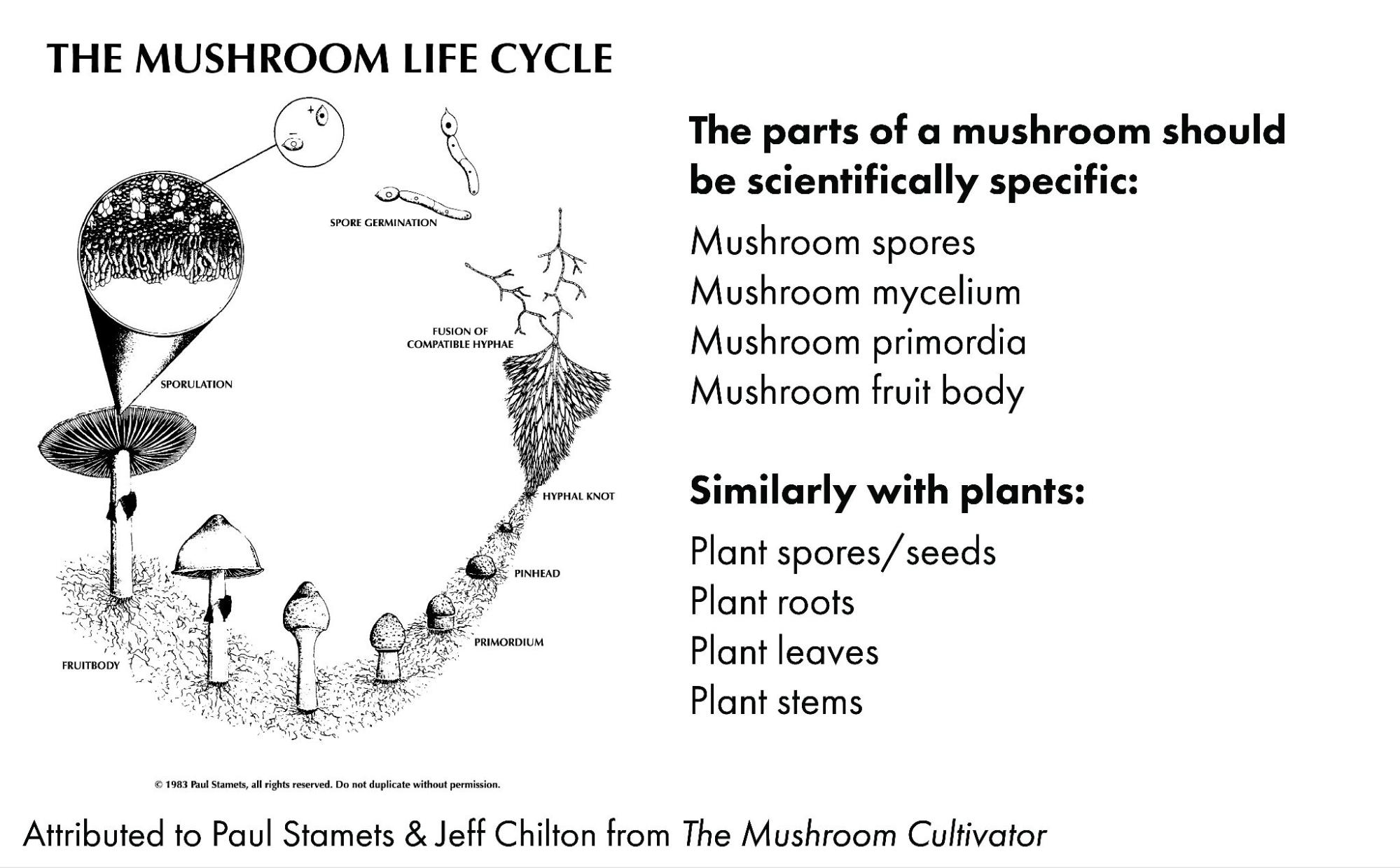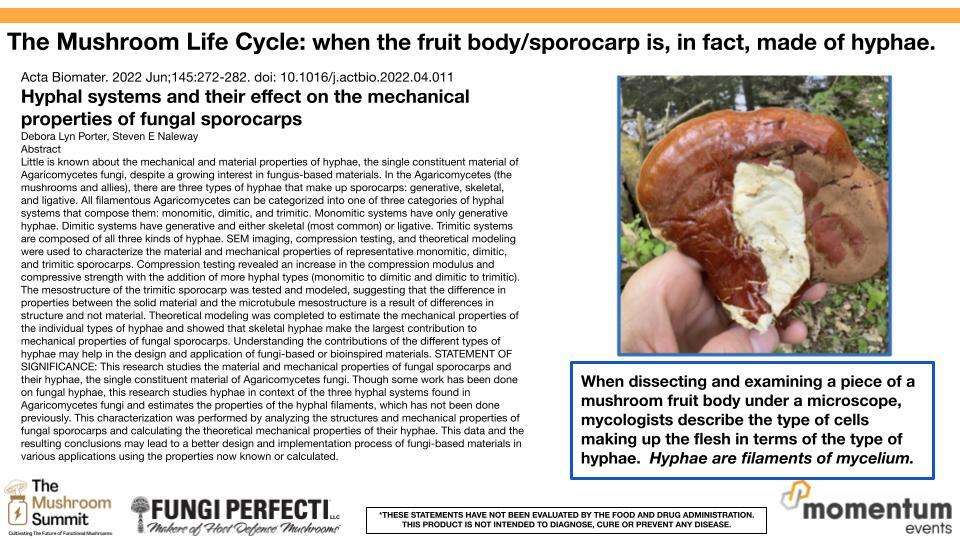AN OPEN LETTER FROM DIVERSE-STAKEHOLDER MUSHROOM COMPANIES ON NAMMEX CITIZEN PETITION TO FDA
Although Fungi Perfecti, LLC, M2 Ingredients Inc., Gourmet Mushrooms, Inc., and Monterey Mushrooms Inc. are competitors, we are unified to emphasize the importance of conveying scientifically accurate information to the public, to FDA, and to other thought leaders in the field. From this standpoint we are responding to the puzzling opinion presented in the recent FDA Citizen Petition submitted by Nammex, and find that their position obfuscates the use of well-established mycological definitions.
In this Citizen Petition, Nammex advocates to eliminate the use of the word ‘mushroom’ in products using mushroom mycelium. Our collective use of ‘mushroom mycelium’ is scientifically accurate, just as the use of ‘mushroom spores’, ‘mushroom fruit bodies’ are descriptively accurate. The word “mushroom” describes the organism itself, whereas terms like “mycelium” and “fruit body” refer to distinct parts of the mushroom organism. This is perfectly parallel to saying ‘plant roots’, ‘plant seeds/spores’, and ‘plant flowers’. Both sets of terminologies describe the parts of the organism. To propose the elimination of the word “mushroom” (again, the name of the organism), results in confusion; for example, “mycelium” on its own would not distinguish mold mycelium from mushroom mycelium. Below The Mushroom Life Cycle diagram, as it appears in The Mushroom Cultivator by Paul Stamets & Jeff Chilton, depicts clearly-named stages of the mushroom life cycle.

When mycologists dissect a mushroom fruit body and examine a sample under the microscope, they typically describe the tissue in terms of the types of hyphae that compose the mushroom. What are hyphae? Hyphae are filaments of mycelium. Mushroom fruit bodies are made of compacted mushroom mycelium. The recent article Hyphal systems and their effect on the mechanical properties of fungal sporocarps describes how hyphae (filaments of mushroom mycelium) construct a sporocarp (mushroom fruit body). A mushroom fruit body is comprised of mushroom mycelium physically organized in a distinct structure as compared to the mushroom mycelium network-like stage. The word ‘mushroom’ can both be a noun and used as a qualifier as to the stage of the life cycle.

In its Citizen’s Petition, Nammex also advocates for label disclosure of the “fungal part/growth stage” of mushroom ingredients. Here, we agree.
American Herbal Products Association (AHPA) produces “guidance documents on labeling to help the industry comply with applicable laws and regulations, and to institute best practices that help ensure quality and transparency.” For mushroom dietary supplements, their labeling guidelines state that:
American Herbal Products Association (AHPA) produces “guidance documents on labeling to help the industry comply with applicable laws and regulations, and to institute best practices that help ensure quality and transparency.” For mushroom dietary supplements, their labeling guidelines state that:
‘Ingredients other than dietary ingredients in such products are disclosed in the product label’s ingredient list preceded by the words “Other ingredients,” as described in 21 CFR 101.4(g) ….if any are still remaining in the fungal ingredient; other non-dietary ingredients used in the manufacture of the dietary supplement product, i.e., excipients such as fillers, binders, flow agents, etc.; and non-dietary ingredients that are ingredients within ingredients and are present in non-trivial amounts, such as excipients that are added to an extract (e.g., maltodextrin or the marc from the extraction starting material (e.g., “shiitake fruitbody marc”).’
AHPA guidelines emphasize that extracts sprayed back onto the marc must be disclosed. To this day, consumers purchasing products made from mushroom fruit body extracts think they are purchasing a concentrated mushroom fruit body extract powder, when in fact they are buying a mushroom fruit body extract that is dehydrated and sprayed back onto the spent marc without disclosing. This is deceptive.
A mushroom fruit body extract typically has a range of 2-8% solids. This means that 90+% of the product
weight is composed of dehydrated, inert marc and not identified on the label. Nammex’s sister brand Real Mushroom, which markets mushroom fruit body extract powders, does not publicly disclose whether their extracts are sprayed back upon the marc or are pure extracts absent the marc.
Moreover, Nammex recommends using a questionable method for detecting beta glucans known to give widely disparate results. The beta glucan test that Nammex recommends is not currently a validated AOAC (Association of Official Agricultural Chemists) method for testing beta glucan content in mushroom ingredients in part due to its unreliability for consistent results. Furthermore, beta glucans are but one beneficial compound available within mushroom ingredients, and their presence alone does not indicate biological activity.
As experts, we continue to be concerned by confusion seeded by Nammex of widely-accepted and settled terminology, and are moved to write so that industry policies will be grounded in scientific accuracy. This is critical for clear and sound regulations. We advocate for truth and scientific accuracy in labeling. In our opinion, Nammex’s proposals do neither.
We do not have any issues with mushroom fruit bodies. We utilize this life stage as well. We find mushroom
mycelium has added benefits as demonstrated by scientific research. Please see www.mushroomreferences.com for hundreds of references published in peer reviewed journals for both mushroom mycelium and mushroom fruit bodies.
More information available at your request.
In unity, we respectfully submit.

Paul Stamets, Member & Founder, Fungi Perfecti, LLC

David Law, CEO, Gourmet Mushrooms, Inc

Steve Farrar, President, M2 Ingredients, Inc.

Shah Kazemi, CEO, Monterey Mushrooms
